 Air travel can wreak havoc on your skin, mainly because of the dry cabin air. This zaps off the moisture of your skin, leaving it looking dull and dry. The recycled air inside the plane, furthermore, can allow the dirt, bacteria, and other chemicals to circulate around and potentially affect your skin.
Air travel can wreak havoc on your skin, mainly because of the dry cabin air. This zaps off the moisture of your skin, leaving it looking dull and dry. The recycled air inside the plane, furthermore, can allow the dirt, bacteria, and other chemicals to circulate around and potentially affect your skin.
Here are the other ways flying affect your skin:
- Higher altitude means less blood flow to the skin, making it look dull and aging. Arid air and lack of humidity can also leave the skin dry and dehydrated. The skin will then try to overcompensate for the dryness, resulting in oiliness in the cheeks, nose, forehead, and chin.
- Flying brings you much closer to the sun, which increases your risk of UV-related skin damage. This is especially true if you always get the window seat.
- Inactivity or lack of moving space can lead to water retention, especially in the joints and ankles. This can also show up on your face, resulting in some puffiness.
- Stress is common during air travel and sometimes creates a level of anxiety among flyers. The increase in stress hormones can trigger skin issues like redness and other skin-inflammatory conditions.
Here’s how you can protect skin when flying:
Take a break from makeup
When paired with makeup (especially heavy foundations), recirculated air and low humidity in the plane can contribute to acne and blemishes. You should also know that some cosmetic products can be drying on skin and hold onto to dirt and other impurities that can lead to free radicals.
This is why it is best to avoid makeup whenever possible. If you, however, can’t go bare faced, be sure to go light or choose lightweight formulas that are right for your skin type. Mineral makeup or those labeled non-comedogenic are a good option, as they are less likely to clog your pores.
Don’t forget sunscreen
Applying sunscreen is more important when flying as you are closer to the sun. This also means that the UV rays (that can penetrate the windows) are much stronger and can cause more damage to your skin. Be sure to look for a broad-spectrum sunscreen that offers protection for both UVA and UVB rays.
We recommend Clear Defense SPF 45 with Broad Spectrum and Sheer Defense Tinted SPF 46 with Broad-Spectrum from Dr. Sylvia. Both products are lightweight, fast absorbing, and provide the skin with broad-spectrum coverage from UVA, UVB and infrared radiation.
Apply a hydrating or anti-aging serum
The cabin pressure, recycled air, and lack of oxygen during your flight can leave your skin puffy and dehydrated. To soothe the skin and protect it against environmental stressors, use a hydrating or anti-aging serum. You can apply the product after cleansing and before moisturizing.
Dr. Sylvia’s Vitamin C 20% with Ferulic Acid is one good option, as it helps combat oxidative stress. It also provides additional hydration and skin lightening benefits. You can also consider Fibroblast Growth Factor Serum from Dr. Sylvia. This boosts skin density, texture and firmness, as well as reactivate collagen and dermal activity.
Keep your skin hydrated
Lack of humidity and dry cabin air can dehydrate and irritate your skin, as well as accentuate the appearance of fine lines. We suggest using a formula that provides superior levels of hydration like Dr. Sylvia’s Deep Hydrating Moisturizer.
This oil-free moisturizer is effect in restoring moisture in the skin without clogging the pores or triggering breakouts. It contains seaweed combined with hyaluronic acid that work together to provide protection and moisture necessary for healthy skin.
Don’t let your skin suffer while flying. Follow these skincare tips and visit this link to purchase the products mentioned above.
- If you would like to be an informed patient, please contact us at +65-6801-4000 or
hello@cutislaserclinics.com. - Cutis Medical Laser Clinics, 9 Scotts Road Pacific Plaza, Scotts Medical Center #08-07, Singapore – 228210
+65-6801-4000 - hello@cutislaserclinics.com
